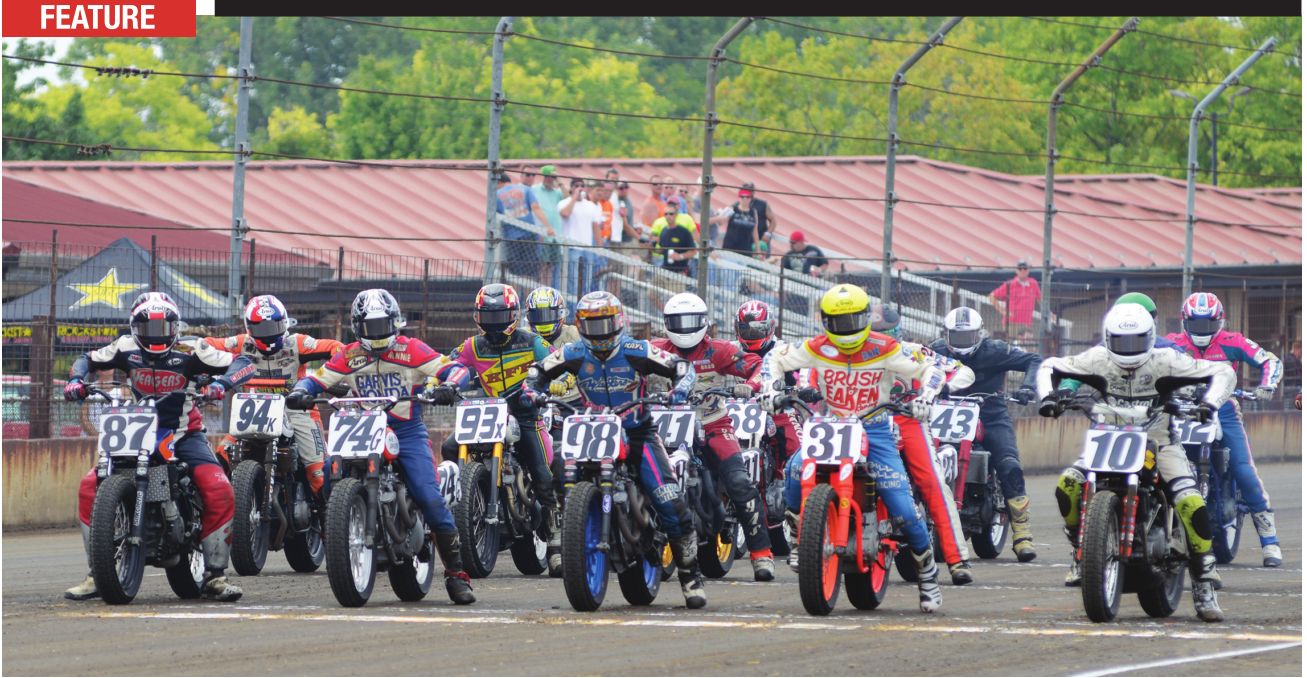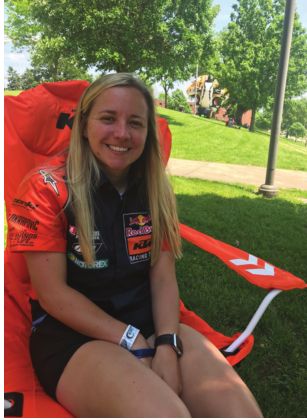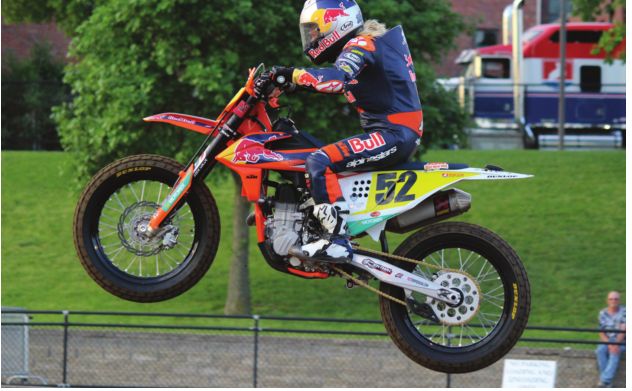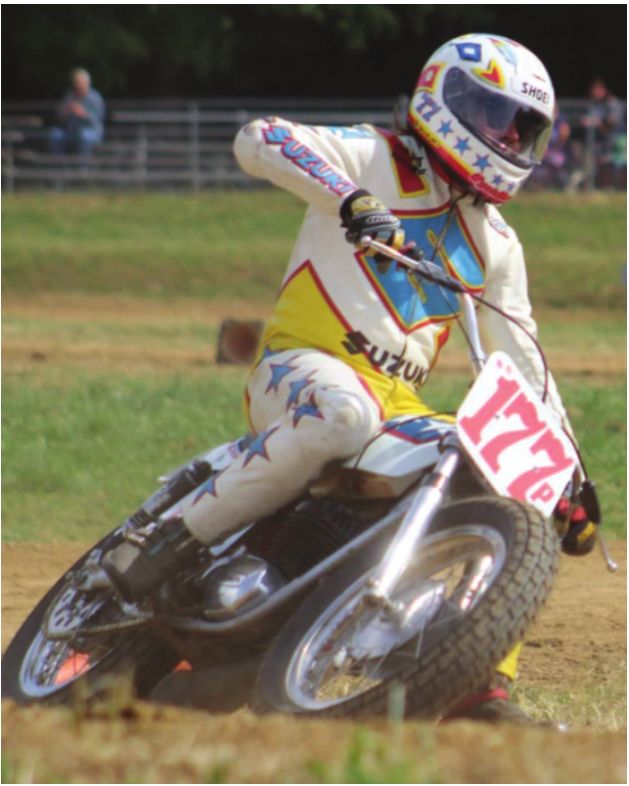
Springfield is a racing mecca
Shayna Texter once dreamed of playing pro soccer, but she can’t escape the thrill of speed that is in her blood.
In 2012, she made history in Tennessee by becoming the first woman to win a Grand National Championship race. Sanctioned by the American Motorcycle Association, such races are considered the sport’s top echelon. At 28, she’s comfortable in a sport dominated by men and danger. She’s the only woman expected to compete in the Springfield Mile on Labor Day weekend, a race with deep roots in motorcycling history that draws both riders and fans from across the nation. “Shayner Texter may just be the best racer in America,” Bloomberg magazine wrote in a story published last year about the growing popularity of racing motorcycles on dirt ovals, which, if you’re good enough, can become a bona fide living.
Texter’s love for motorcycles shouldn’t be surprising. Her grandfather and brother raced bikes, and her brother also inherited a love for racing flat track. Growing up in Willow Street, Pennsylvania, she started riding at age 3 but soccer was her first love. When her dad retired from racing in 2003, she says she “shifted gears to riding motorcycles. And, I haven’t looked back since.”
She started her pro career on single-cylinder 450cc bikes, then moved up to heavier twincylinder motorcycles with more powerful engines, which she raced for two years until 2016. During that time, she raced against her brother, Corey, and nearly crashed into another racer, Briar Bauman, who then became her boyfriend. She since has switched back to the 450 cc class.
“I’m the smallest rider in the series,” she says. Racing motorcycles are light, but not as light as Texter, who weighs 100 pounds and rides bikes weighing about 230 pounds. Recently, she joined the Red Bull KTM factory racing team to become the first rider of singlecylinder flat-track bikes to land full factory sponsorship. She’s cultivated a following in a sport where more powerful twin-cylinder bikes have traditionally gotten the most attention.
The home court isn’t always an advantage.
In a 2017 preliminary race, Texter recalls getting a flat tire in front of relatives and friends who had gathered at a Pennsylvania track to watch her perform. She didn’t qualify for the main event. “That really stung, and it makes me enjoy the race wins that I get,” Texter said.
With some impressive wins, she says that she now feels at ease. Her timing is perfect, as the sport of racing motorcycles on dirt flat tracks has grown more popular, with sponsorships and television deals mushrooming in recent years. There was a time when most racers held down full-time jobs off the track and racing was a seasonal endeavor. For instance, her father worked at her grandfather’s Harley Davidson dealership back in the day. But there is no off-season anymore for professionals like Texter. “I’m consumed in the everyday work of soliciting sponsorships and funding, and participating in media activities for current and future sponsors,” she says.
With her helmet off, Texter is as adept with fans as she is with rivals on the track. When pits open for fans seeking autographs and behind-the-scenes glimpses of stars, the lines around Texter have been long and include lots of dads with daughters, says Michael Lock, chief executive officer of professional racing for the American Motorcycle Association.
If there is any hint of sexism bias in motorcycle racing or coverage by the media, Texter seems unfazed. NBC has hired her to work as a commentator for motorcycle races when she’s not racing herself.
“For years, flat track was America’s bestkept secret,” Texter says. “When I tell people what I do, they are so amazed by how small I am, and how aggressive and close we get on motorcycles.” Qualifying events, where races last between five and 15
laps, are tougher than main events that can be twice as long, Texter
says. “The shorter races are always harder,” she says. “Your adrenaline
is going the whole time. You have to tell yourself to just breathe.
There’s days that are more stressed out than others. There are some
races when I definitely wish it would rain out. But you need to show up,
prepared one hundred and ten percent.”
Texter
recently earned a bachelor’s degree in exercise science, which she
figures might come in useful when her racing days are over. Fitness is
vital on the racetrack, where riders must maneuver powerful machines
through a combination of finesse, balance and strength, with little room
for error.
Texter’s
trainer ensures that she stays in top physical condition with
cardiovascular workouts, bicycling, running and various gym-based
exercises. “We try to eat clean, eat at home, limit sodium and carbs,”
Texter says. “We can’t completely give up meat, so we still eat fish or
chicken with rice and vegetables.”
While
Texter has a fan base, she also has her own role models, including
soccer star Julie Ertz, recent World Cup champion, and Ertz’s husband,
Zach, a tight end with the Philadelphia Eagles. “I enjoy watching how
they balance their relationship with their professional sports,” she
says. She sees parallels in her own life.
“I
date Briar Bauman, who is leading the championship (points race) on the
twins side,” Texter says. “It’s like we have double the workload to
support each other and make sure that we’re both doing well on race
day.”
We’ve got a reputation 
The
Springfield Mile is actually a pair of twoday racing events at the
state fairgrounds, one held on Memorial Day weekend and the other on
Labor Day weekend. Over the past 80 years, the mile-long track at the
fairgrounds has become one of the most celebrated racing venues on the
planet. For many years, whoever won the Springfield Mile was considered
the best flat-track racer in the world, no matter how many other races
they won or lost, and so was entitled to wear the numeral one on their
handlebar-mounted number plate.
Racing
motorcycles on unbanked dirt or clay ovals is a uniquely American
endeavor that has gone worldwide. Born and raised in Britain, Lock, CEO
of the American Motorcycle Association, was hired in 2015 to help
revitalize flat track racing. With experience working for such European
motoring companies as Ducati and Lamborghini, Lock has succeeded to the
point that flat-track motorcycle racing now rivals NASCAR as a marquee
motorsport in the U.S.
Motorcycle
racers from as far away as Australia compete in the Springfield Mile,
where riders are expected to be athletes and equipment highly tuned and
state of the art. Flat track racing, Lock and others figure, will only
grow in popularity. “That’s because, in this American sport which began
locally and regionally, rider performance is still key,” Lock says. “The
bikes are still widely accessible, as compared to the six-figure price
tags on Moto Grand Prix ultra high-tech machines, which are identified
as primarily European.”
There’s
more to flat-track motorcycle racing than the latest technology. Lock
sees potential in marketing events featuring vintage bikes, and so he’s
expanded the race schedule in Springfield and elsewhere to include races
that showcase machines that are decades old. In Springfield, upcoming
Labor Day weekend races will begin with vintage racing Aug. 29, an
opening act of sorts designed to draw fans of all ages. Count on Sam
Evans being there.
Evans,
a central Illinois native, raced in the 1970s and 1980s before
launching a career in construction and real estate, which he holds are just
as risky as speeding around a track at high speed. His love for racing
never left. Today, he races a 1971 Ossa Stiletto TT, which he bought
brand new from a showroom floor while still in high school. “Vintage
motorcycles should be shared, not hidden under a tarp in the garage,” he
says. “I race them because I can’t think of a better way to display a
vintage bike than at a racetrack with the sound and smell of a
twostroke, running on bean oil and high-octane fuel in the air.”
Don
Evans, Sam’s father, also raced flat track and shared stories about
legends of the sport such as Bill Tuman, winner of the 1953 Springfield
Mile, with his son. Sam’s mom, Nancy, also raced motorcycles in the
1950s and 1960s, competing in hill climbs up impossibly steep slopes
instead of speeding around dirt tracks. Sam’s second cousin, Joe, raced
flat track, as did Sam’s uncle, who rode the same Indian Scout as Sam’s
mother in hill-climbing competitions. The Scout is still owned by the
Evans family.
Vintage
motorcycle racing forums inhabit the internet, catering to folks like
Evans who are intrigued by aesthetics and mechanics of motorcycles from
bygone eras. Retired racers say that restoring bikes, then racing them,
can be a comeback therapy of sorts that demands both mechanical know-how
in the garage and skill on the track.
A truly American invention
The
physical, cultural and aesthetic tale of dirt track racing is an
American story that begins around the time that the Wright brothers
invented the airplane. Talking to Evans during Springfield Mile weekend
last May proved a window into the world of the sport’s history and
culture.
The
earliest races unfolded on board tracks designed for bicycles, with
crowds gathering at fairs and sundry expositions to watch daredevils
careen around wooden ovals that became increasingly slick with oil with
each lap. Full throttle racing found a home in Springfield during the
1920s, when a grandstand was erected at the fairgrounds and soil from
Sangamon River bottoms was brought in to create a mile-long racing
surface that became legendary.
The
Springfield Mile was officially born in 1937, when the American
Motorcycle Association first sponsored a race. J. Lester Hillbish of
Reading, Pennsylvania, won the checkered flag, besting 96 competitors in
a 25- lap event, covering the 25 miles in 20 minutes, 18 seconds. He
died in 1977 at age 63 and was inducted into the American Motorcycle
Association Hall of Fame in 1998.
The
Springfield Mile was suspended during World War II, but when racing
resumed in 1946, it was a Norton, made in Britain, that carried Chet
Dygraaf to victory and the title of national champion based solely on
winning in Springfield. Harley Davidsons soon dominated the sport, with
rivalries between brands continuing to the present day.
Bill
Tuman of Colona won in 1953, marking the first time that an Illinois
rider won a national championship by virtue of winning the Springfield
Mile. Tuman and fellow racers Ernie Beckman and Bobbie Hill, who won the
1951 Springfield Mile, came to be known as the Indian Wrecking Crew,
regularly besting riders aboard Harley Davidsons in a sport where fans
tend to identify with whoever is riding the same brand as they favor.
The
Springfield Mile, which had been held during the state fair, was
suspended in 1967 due to what authorities considered excessive rowdiness among race fans.
Racing resumed during the 1980s, when serious money came into the sport
and purses swelled to nearly a half-million dollars. But the growth of
NASCAR soon outstripped interest in motorcycle racing.
To
Jerry Stinchfield, owner of Roof Systems of Dallas, whose company
supports a 10-racer flat-track team that includes Texter, it seemed like
the sport was on life support during the 1990s and 2000s. Stinchfield
is a lifer, having watched races as a kid, then, briefly, becoming a
competitor himself. “I’m in it now because I know what these kids can do
at all levels, and how hard they work.” Stinchfield said.
Years
ago when the sport was struggling, promoters of Springfield’s Ethnic
Festival at the State Fairgrounds dovetailed events to coincide with
dirt track racing, hoping to catch waves of out-of-state racing fans who
might respond to the call of cold beer and gyros served on sticks.
Things have progressed beyond gyros.
Beyond
faster bikes and racers who train like the athletes they are, the
American Motorcycle Association, under Lock’s direction, has forged a
partnership with NASCAR to livestream flat-track races that unfold at
speeds approaching 140 mph and no brakes to get in the way. The
internet-based service has been a game changer that’s expanded the
sport’s audience beyond usual suspects, Lock says. “We now have
sophisticated metrics and data that shows we’ve gone from a ratio of 90%
male and white who attended live motorcycle racing events for years, to
now capture a wider demographic that is much younger and more like 75%
male and 25% female.”
Catherine
O’Connor is an independent journalist and social historian who often
has trouble accelerating up to speed entering freeway onramps, but now
has respect for athletes who go “left and fast” in the ballet called
American flat track racing.